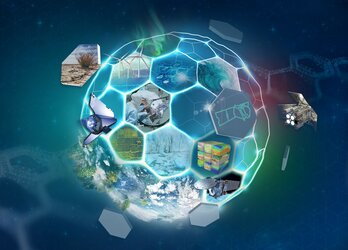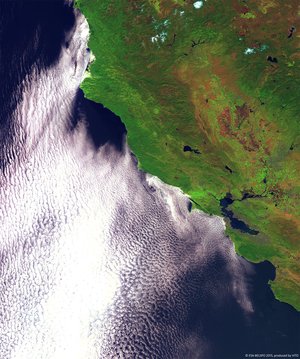From Blu-ray players to Earth-observing missions
Andrew Barnes, Senior Technology Engineer
If you have a Blu-ray player than you own a tiny crystal of Gallium nitride (GaN) – used in high-performance blue lasers. Versatile GaN has been called the most promising semiconductor since silicon.
Its ‘wide bandgap’ nature means it can operate with high RF output power, low noise, or at high temperature – silicon electronics will not function beyond about 180ºC but GaN will go on working at temperatures as high as 500 ºC to 600 ºC. As a plus, it is also inherently radiation resistant.
GaN has all kinds of potential uses, including photonic devices, high power amplifiers for communications systems, DC to DC power conversion, new types of sensors and in higher efficiency solar cells. More than a decade ago it was clear that GaN would be an enabling technology for space, and ESA needed to get involved with it. The question was how?
Europe has had past experience where good work at the research institute fails to translate into market success. In the end we can only afford a space sector because it pays for itself in global markets, therefore a ’multi-use’ application of this technology is essential. Also, we were conscious that overseas governments were investing heavily in GaN technology and did not want to risk that access to key space technologies ends up vulnerable to foreign export restrictions, compromising European non-dependence and competitiveness.


Access the video
We knew we had to get involved early on in the development cycle, to make sure the underlying technology was suitable for space with no showstoppers. Space is too niche a market for manufacturers to make process changes later on, it is better to be there at the start and have a 'seat at the table' to ensure space requirements are considered. In the long run this accelerates the overall space development cycle and shortens the time required to achieve space qualification. We also decided we needed a coordinated effort, combining a seamless programme of work continuously funded across multiple TEC programmes (mainly TRP and GSTP) – because this was not simply an individual technology development but the creation of an entire European supply chain.
The result, in 2008, was the ‘GaN Reliability Enhancement and Technology Transfer Initiative’ (GREAT2), which continues to this day, a consortium of research institutes, design companies and leading manufacturers, developing space-quality GaN products on an end-to-end basis, with radio frequency amplifiers our initial focus. Activities range from scientific investigations of the underlying device physical processes to evaluating production and packaging methods and performing reliability testing across hundreds of thousands of hours of operation. An important part of this was to also perform independent testing in the ESA materials and components laboratories to verify the results of industry and gain confidence in the techniques being implemented.
An important step came in 2013, when we demonstrated our first GREAT2 product in orbit
An important step came in 2013, when we demonstrated our first GREAT2 product in orbit: a GaN amplifier incorporated within the X-band telemetry transmitter of the Proba-V minisatellite. Today it is used routinely to return mission data to the ground, together with a conventional transmitter counterpart based on existing gallium arsenide technology. Its output power and data rate can in principle be boosted as needed, increasing the mission’s operational flexibility. We’ve been following it closely, but after more than three years in orbit the amplifier shows no drift in performance.
This pioneering effort in Europe has led to wider interest. The methodology developed within GREAT2 is currently being used to test hundreds of GaN solid-state power transistors to be supplied to ESA’s Biomass mission, harnessing a novel radar band to map global forests. These transistors shall be used to realise solid state power amplifiers, taking the place of bulky travelling wave tubes and it’s no exaggeration to say that without GaN technology the Biomass mission would not even be feasible in its present form. GaN is also being considered for follow-on Sentinels and Europe’s next-decade Galileo Second Generation.














 Germany
Germany
 Austria
Austria
 Belgium
Belgium
 Denmark
Denmark
 Spain
Spain
 Estonia
Estonia
 Finland
Finland
 France
France
 Greece
Greece
 Hungary
Hungary
 Ireland
Ireland
 Italy
Italy
 Luxembourg
Luxembourg
 Norway
Norway
 The Netherlands
The Netherlands
 Poland
Poland
 Portugal
Portugal
 Czechia
Czechia
 Romania
Romania
 United Kingdom
United Kingdom
 Slovenia
Slovenia
 Sweden
Sweden
 Switzerland
Switzerland




























